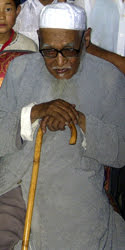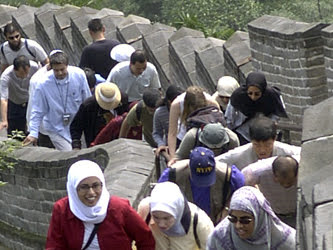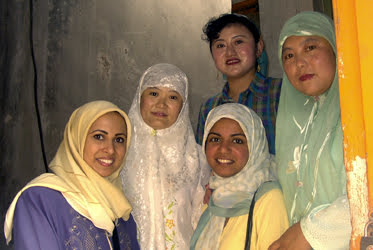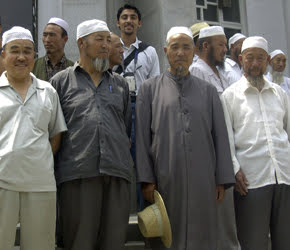The Hui Against All Odds: Exemplars for American Muslims
By Abd al-Rahman Benavidez
In the summer of 2002, the Nawawi Foundation organized and lead a group of some one hundred American Muslims on a tour throughout China that included five provinces across the vast continent from the capital Beijing to the heartland Xian and finishing at the great metropolitan and commercial city Shanghai. More meaningful than a tour, it was a journey that focused on the little known ethnic Chinese Muslims, or Hui, and their monuments dating back to the ancient Islamic civilization established by their ancestors.
One may ask: of all the places and people to visit, why China and the Chinese Muslims? Each one of us imagined what China would be like at the onset of the rihla (journey), and each of us hoped to experience something special that would make a rewarding and memorable impression for many years to come. For some maybe, it was a longing to pray in an ancient mosque or to sit and drink tea in the home of a Chinese Muslim family. For someone else it was perhaps the wish of bargaining in an old market for that one of a kind handmade silk rug. However, Dr. Umar Abd-Allah, chairman of the Nawawi Foundation, capsulated our purpose well when he told a group of Hui: “We have not come to teach you but to learn from you”. And so it was precisely for this reason that we traveled to that region of the world fulfilling, in sha Allah, the well-known prophetic tradition regarding the attainment of knowledge in China: “Seek knowledge even unto China.”

Although we knew almost nothing about the ancient Chinese Muslim civilization we were about to visit, we had surety in the timeless words of the Messenger of God (sa), and so sought inspiration from a people who achieved what we hope to realize in the United States. Indeed, the achievement of the Hui is particularly informative for us today given that they established a successful Islamic society that blossomed within a highly sophisticated non-Muslim civilization. The Chinese Muslims embraced a religion that emerged from Arabia, but they never lost their sense of cultural and ethnic identity. They maintained the sanctity of their indigenous roots and ancient symbols and created a culture and civilization that was both Chinese and Islamic. The Hui took into careful consideration the ethos of China’s ancient cultural wisdom together with the spirit of Islam and produced an identity that was not only indigenous but also distinct from Arab or Persian Islam.
Furthermore, Chinese Muslim culture distinguished the name of their faith with one that was in accordance with China’s philosophical tradition. Rather than referring to their faith as the religion of Islam, the Hui called it: qing zhen jiào (the religion of the pure and real) [more on this]. It was perhaps the cultural familiarity along with the success of the Hui in society that prompted the Tang dynasty (618-907) to accept Islam as an official Chinese religion of the empire-unlike Christianity, which was considered foreign. Throughout the various dynasties up to the last, the Hui, although minorities, had self-governing powers.
Unfortunately, our knowledge of the Hui and their achievements is nominal. Their legacy has been largely ignored by historiographers, thus little has been written about them. We may never fully understand this important story of our Islamic legacy. Records along with human life were destroyed when Chairman Mao came into power and founded the People’s Republic of China in 1949. All manifestations of religion were oppressed, including Islam. Places of worship, schools, and other institutions were closed. It is estimated that some 29,000 mosques were destroyed while many others were used as warehouses. Today, the government’s attitude toward religion is different. The Hui are permitted to practice Islam but they are held with suspect. Although much about the Hui is unknown to us, the magnificent monuments their predecessors left behind are not negligible. I was fortunate to catch a glimpse of the art and architecture crafted by the hands of God’s worshippers.

The first mosque we visited was in Beijing. Located on the street that bears the name of the mosque, the Nuije Mosque was built in 996 and is the oldest and largest in the city. Surrounded by a stonewall, the mosque is unassuming within the bustling capital. Unlike the lofty minarets of the Ottoman mosques (of Anatolian inspiration) that are visible to the eye from several kilometers, they are absent in the Nuije Mosque. Not only are there no minarets, but also there are no domes. In fact, the mosque resembles a Buddhist temple. The roof is constructed in the style called zaojing, a traditional roof design found throughout the land. The mosque’s vibrant colors and gardens beautified the courtyard while bringing tranquility to the heart. However, the differences between the mosque and temple soon became apparent after we entered the prayer hall. The ancient hall is not decorated with human representations but instead with both Chinese and Arabic calligraphy, characteristics that would reoccur throughout the journey.
Once we finished praying, I wandered about the courtyard knowing it would probably be my last visit. I then heard faint murmurs coming from a small hall within the courtyard and decided to probe the matter. Feeling apprehensive, I peeked through the window to find some twenty elders sitting around a table learning how to recite the Quran. It seems they were the unfortunate victims of a law that banned the studying and teaching of the Quran but who had decided to reconnect themselves with the Book of God. Despite the ancient history behind the mosque, believing men and women bow down in prostration to Allah to this day.
The humility and generosity displayed to us by our hosts is what I believe had the greatest impact upon us all. They were characteristics derived from the love of their religion as revealed to us by a poem in praise of the Prophet Muhammad (sa) sung to us by a choir of shy students from the Gansu province. In a region of the world unbeknownst to us was the name of God and His Messenger (sa) being remembered and praised by a people who until recently were persecuted for mentioning these very names. No matter the province or mosque we visited next, every community had something to offer: sweet watermelon or even a smile.
As a write, I can’t help but still feel the humility that radiated from the faces of the people I encountered. After every visit to a mosque, we would leave the prayer hall to find carved up watermelon waiting for us on tables in the courtyard, gifts provided by the community. None us will forget the afternoon when we trekked along a dusty road in the city of Langxia to reach one of the few schools in the country dedicated to teaching Islam. As we approached the school, we passed by a tiny old woman wearing a tattered headscarf who, after being told by one of the locals who we were, began to weep in the middle of the road. She was overcome with joy to know that so many strangers from another land came to visit her community. Her city was also known as Little Mecca, home to some 300 thousand Muslims.

The next “Muslim” experience took place in Xian. The city was the ancient capital for eleven dynasties, including the Tang, and was the starting point of the Silk Road. Hence, the former imperial city contains some of the world’s art and architectural treasures that includes the Terracotta Warriors. Xian is home to a community of 60,000 Muslims, which supports several mosques, a primary school, shops, and restaurants; and therefore constituting an integral part of Xian’s daily life-for over 1250 years. Arabic writing above the entrance of many restaurants verifies their Muslim ownership. The majority of the community resides in the Huajue Xiang district, and in the heart of the community lies the Great Mosque of Xian. According to the historical record that is a stone tablet still preserved within the mosque, it was constructed in 742 C.E. In the shape of a rectangular from east to west, the complex occupies an area of 13,000 square meters and is subdivided into four courtyards.
The mosque is approached via a labyrinth of narrow streets lined with shops and restaurants with signs in the window that read in Arabic halal. The entrance is through an ornamented wooden archway with glazed roof-tiles, and just ahead, an engraved sign in calligraphy informs us that we have entered “The Court of Heaven”. Like the Nuije Mosque, the design of the Great Mosque is completely Chinese in character. Behind the engraving are two stone tables erected with decorations of carved dragons, which give an account of the mosque’s repairs at the imperial orders of emperors from the Ming and Qing dynasties. Indeed, ancient symbols are present throughout they courtyard: the lotus, pagoda, and dragons. In the center of the courtyard is what appears to be a pagoda but is actually a minaret, called the “Introspection Tower”. The two-story structure is also Chinese in character with three layers of upturned eaves and an octagonal roof. Also, in the courtyard is a kiosk named “One God Pavilion” that is hexagonal in shape and designed with upturned eaves. Noteworthy is a calligraphic inscription written by a high official of the Ming Dynasty that proclaims: “One God”. Ibrahim Abusharif, a member from our group, reflected on the Great Mosque and wrote, “The overall look of the architecture is in the shape of a phoenix with open wings”.

At the eastern end of the courtyard is the Prayer Hall. A just description of the hall is beyond words. Abusharif states, “Your first impulse is to pray”. Few and far between, areas of worship such as this hall have the power to remove disharmony within the soul and bring stillness to the heart. We didn’t want to leave. All of us kept looking around awestruck by the walls decorated with hundreds of intricately carved wooden panels comprising the entire Quran with translation and commentary.
Upon leaving the ancient house of worship, we were to experience one more surprise. A small group of us passed by one of the halls in the courtyard and was invited in by a caretaker. Soon after the imam walked in, who was apparently informed of the presence of a large contingency of Americans wandering throughout the mosque. He must have been in his late sixties and had a somewhat serious demeanor, but this did not refrain him from being hospitable and open with us. He invited us to sit down with him, and the erudite Dr. Umar was our diplomat representing us in this cultural dialogue between the two worlds.
The imam told us the fantastic story of how the Great Mosque was nearly destroyed by the Red Army during the Cultural Revolution. At the time, he was a young and new imam. All of us sat with excitement listening to the story told in Chinese, which was translated into Arabic and then explained in English. The community received word that the army was marching toward the city with the orders to destroy religious monuments. To prevent the mosque’s destruction, all of the men from the community decided to surround it and defend it with their lives. However, the imam had a different plan. He called the men to back away and let the army, consisting young peasants, enter the courtyard whereby he asked the soldiers if they were interested in hearing the story of how the Great Mosque was constructed. He had the soldiers so enthralled that when he finished the story the requested to hear more stories to which the imam replied: “Yes, but not today. Come back tomorrow and I will tell you more.” The intended result not only avoided bloodshed but also disengaged the soldiers’ drive; and when they left, they apparently did not have the energy to return to finish the job.

